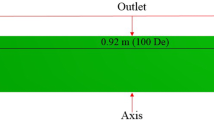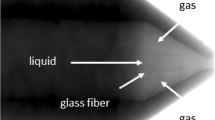Abstract
A simple one-dimensional (1D) computational fluid dynamics (CFD) model of the chemical oxygen iodine laser (COIL) with supersonic mixing is compared with three-dimensional (3D) CFD models and with experimental measurements of the COIL parameters. Dependence of the gain, iodine dissociation fraction and temperature at the resonator optical axis and of the output lasing power on the iodine flow rate predicted by the 1D model is in good agreement with that found using 3D models and experimental results. Hence the 1D model can be used instead of much more complicated 3D models for estimates of the working parameters of supersonic COILs.





Similar content being viewed by others
References
W.E. McDermott, N.R. Pchelkin, D.J. Benard, R.R. Bousek, Appl. Phys. Lett. 32, 469 (1978)
M. Suzuki, T. Suzuki, W. Masuda, Proc. SPIE 4184, 99 (2001)
T.G. Madden, Proc. SPIE 5120, 363 (2003)
A.S. Boreisho, A.B. Barkan, D.N. Vasil’ev, I.M. Evdokimov, A.V. Savin, Quantum Electron. 35, 495 (2005)
T. Madden, Proc. SPIE 6346, 634620 (2007)
K. Waichman, V. Rybalkin, A. Katz, Z. Dahan, B.D. Barmashenko, S. Rosenwaks, J. Appl. Phys. 102, 013108 (2007)
K. Waichman, B.D. Barmashenko, S. Rosenwaks, J. Appl. Phys. 104, 013113 (2008)
K. Waichman, B.D. Barmashenko, S. Rosenwaks, J. Appl. Phys. 106, 063108 (2009)
K. Waichman, B.D. Barmashenko, S. Rosenwaks, J. Chem. Phys. 133, 084301 (2010)
B.D. Barmashenko, A. Elior, E. Lebiush, S. Rosenwaks, J. Appl. Phys. 75, 7653 (1994)
A. Elior, B.D. Barmashenko, E. Lebiush, S. Rosenwaks, Appl. Phys. B 61, 37 (1995)
D.L. Carroll, AIAA J. 33, 1454 (1995)
B.D. Barmashenko, S. Rosenwaks, AIAA J. 34, 2569 (1996)
T.T. Yang, R.A. Cover, V. Quan, D.M. Smith, A.H. Bauer, W.E. McDermott, D.A. Copeland, Proc. SPIE 2989, 126 (1997)
E. Bruins, D. Furman, V. Rybalkin, B.D. Barmashenko, S. Rosenwaks, IEEE J. Quantum Electron. 38, 345 (2002)
V. Rybalkin, A. Katz, B.D. Barmashenko, S. Rosenwaks, J. Appl. Phys. 98, 023106 (2005)
V. Rybalkin, A. Katz, E. Bruins, D. Furman, B.D. Barmashenko, S. Rosenwaks, IEEE J. Quantum Electron. 38, 1398 (2002)
V.N. Azyazov, S.Yu. Pichugin, M.C. Heaven, J. Chem. Phys. 130, 104306 (2009)
M.V. Zagidullin, V.D. Nikolaev, M.I. Svistun, N.A. Khvatov, B.T. Anderson, R.F. Tate, G.D. Hager, Quantum Electron. 31, 678 (2001)
B.D. Barmashenko, D. Furman, S. Rosenwaks, Appl. Opt. 37, 5697 (1998)
J.A. Miller, E.J. Jumper, AIAA J. 32, 1228 (1994)
R.F. Heidner III, C.E. Gardner, G.I. Segal, T.M. El-Sayed, J. Phys. Chem. 87, 2348 (1983)
W. Rigrod, IEEE J. Quantum Electron. 14, 377 (1978)
V.N. Azyazov, M.V. Zagidullin, V.N. Nikolaev, V.S. Safonov, Quantum Electron. 27, 477 (1997)
Author information
Authors and Affiliations
Corresponding author
Appendix: Conservation equations in the mixed stream
Appendix: Conservation equations in the mixed stream
The equations for ω(Z) have the form:
where x is the distance along the flow, m(Z) the molecular weight of the Z-component, R(Z) the chemical production rate of species Z, and A is the total cross section area of the mixed stream. Unlike [15], the terms corresponding to entrainment of the primary gas into the mixed layer were not included since, as mentioned in Sect. 2, for the entire mixing the primary stream was absent downstream of the instantaneous mixing in the aerodynamic throat.
The dependencies of A, U and T are found from the mass, momentum and energy conservation equations:



where ω=∑ Z ω(Z), m=∑ Z ω(Z)⋅m(Z)/ω is the average molecular mass, h and c p are the specific (per unit mass) enthalpy and heat capacities, given by h=∑ Z ω(Z)⋅h(Z)/ω and c p=∑ Z ω(Z)⋅c p(Z)/ω, respectively, and h(Z) and c p(Z) are the specific enthalpy of formation and heat capacity for the Z-component.
Rights and permissions
About this article
Cite this article
Brami-Rosilio, I., Barmashenko, B.D. & Rosenwaks, S. Comparison of one- and three-dimensional computational fluid dynamics models of the supersonic chemical oxygen–iodine laser. Appl. Phys. B 108, 615–621 (2012). https://doi.org/10.1007/s00340-012-5007-8
Received:
Revised:
Published:
Issue Date:
DOI: https://doi.org/10.1007/s00340-012-5007-8




